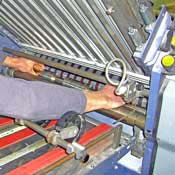 Perhaps you wince at the thought of replacing fold rollers. “What...spend thousands of dollars on recovering rollers?? Naw, just stick some tape on them and we'll be fine.”
Perhaps you wince at the thought of replacing fold rollers. “What...spend thousands of dollars on recovering rollers?? Naw, just stick some tape on them and we'll be fine.”
You might ‘get by’ with a cheap solution like this but your bindery operation will never be competitive. If investing in folder productivity to this extent leaves you feeling squeamish, here are four tips that will help you get over it.
Change your mindset.
Think of fold rollers as a consumable item. The fold rollers are the heart of the folding machine and most today are made from a combination of steel and urethane or rubber. As solid as they are, they wear with use.
Think about how well the machine runs with new rollers.
- Make-ready is much faster with few adjustments needed
- Paper jams decrease and there is less waste
- Quality is better
- Run speeds are higher
Roller wear is slow and it takes an insidious, almost unnoticeable toll on productivity. If you track production, you’ll see it in the averages. If you don’t, you’ll notice that you’re working harder with more overtime. For a high-volume folding operation, a loss of even 5-10% fewer sheets per month equals a big loss of time and money over the course of the year, probably far more than the cost of roller upkeep.
To check if rollers need replacement, insert a strip of light text stock at each end of the roller and set evenly for a light drag. Then insert 3 strips, one at each end and one in the middle. If the middle sheet has no grip, it’s time for new rollers. Repair or replace rollers, springs, washers and bearings as needed and you’ll see an instant boost in bindery productivity.
Follow manufacturers’ directions for setting the rollers
- It only takes a few minutes to set with calipers
- It extends the life of the rollers
- It improves quality overall
- You can always 'cheat' if you need to add pressure but be sure to re-set when done
Ask five folding machine operators how to set the rollers and you’ll probably get five opinions. The best starting point is with what the manufacturer suggests. Later, if experience dictates otherwise, you can change the setup procedure.
For instance, one popular notion is that the strips of paper have to be cut neatly to insert in the calipers. According to Stahl’s 1983 book Folding in Practice, when adjusting fold roller tension on a Stahl “the adjustment strips must be inserted as folded and not as single strips”. That’s how they designed their machines but other manufacturers' machines could differ. It pays to check since an improper setting will affect roller performance and life expectancy.
Perhaps you see operators skip the caliper setting procedure entirely and then struggle throughout a folding run, when a couple minutes inserting the right sheet in the calipers would have prevented the problem. I've even seen operators run their folders with no sheets in the calipers plus excess pressure on the rollers. I never did see an upside to this and the downside of course is an increase in folding problems and premature roller and bushing wear.
Fold rollers need to remain clean to work properly
Dirt, ink, powder all conspire to rob fold rollers of their effectiveness. A small amount of glop in the wrong place can ruin a folder operator’s day. When set correctly most fold rollers will stay remarkably clean but it can’t hurt to take a look at their condition each day and perhaps schedule a regular cleaning, using only the type of cleaner recommended for your rollers.
Think of fold rollers as a tool
If for instance, one folder always runs aqueous coated jobs and it’s a headache to do so, consider switching fold rollers to a combo with open cell foam urethane. It's softer than standard urethane and has a better grip on slippery paper. Perhaps you run numerous glue jobs. Select from a variety of segmented glue rollers with a choice of urethane or rubber materials to suit the job.
Talk to your folder manufacturer or roller supplier; there are toolboxes full of off-the-shelf and custom fold rollers available to suit any application.
An additional benefit: improved fold roller performance means better scoring, perforating and trimming functions. If you do a little honest number-crunching, you’ll see that good fold roller maintenance pays for itself, and it’s a guaranteed way to keep your bindery department productive.
Your comments and stories are welcome below!

